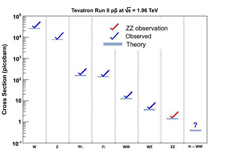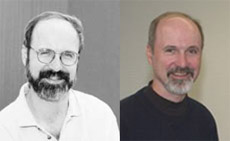|
Wednesday, July 30
3:30 p.m.
DIRECTOR'S COFFEE BREAK - 2nd Flr X-Over
4 p.m.
Fermilab Colloquium - One West
Speaker: J. Buongiorno, Massachusetts Institute of Technology
Title: The Nuclear Renaissance in the U.S.
Thursday, July 31
1 p.m.
Physics and Detector Seminar - West Wing, WH-10NW
Speaker: S. Mishra, Fermilab
Title: The Fermilab 5 Year SRF R&D Plan
THERE WILL BE NO THEORETICAL PHYSICS SEMINAR THIS WEEK
3:30 p.m.
DIRECTOR'S COFFEE BREAK - 2nd Flr X-Over
THERE WILL BE NO ACCELERATOR PHYSICS AND TECHNOLOGY SEMINAR TODAY
Click here for NALCAL,
a weekly calendar with links to additional information. |
|
Wednesday, July 30
- Shrimp gumbo
- Pizza burger*
- Garlic herbs sole
- Mongolian beef
- California club
- Assorted slice pizza
- Chicken Cajun pasta
Wilson Hall Cafe Menu |
|
Wednesday, July 30
Lunch
- Pecan crusted chicken salad
- Carrot cake
Thursday, July 31
Dinner
Closed
Chez Leon Menu
Call x4598 to make your reservation.
|
|
|
Prelude to the Higgs: A work for two bosons in the key of Z
Fermilab's DZero experiment observes rare ZZ diboson production

The discovery of ZZ production (red check mark) is an essential prelude to finding or excluding the Higgs boson at the Tevatron particle collider at DOE's Fermilab.
Scientists of the DZero collaboration at the US Department of Energy’s Fermilab have announced the observation of pairs of Z bosons, force-carrying particles produced in proton-antiproton collisions at the Tevatron, the world’s highest-energy particle accelerator. The properties of the ZZ diboson make its discovery an essential prelude to finding or excluding the Higgs boson at the Tevatron.
The observation of the ZZ, announced at a Fermilab seminar on July 25, connects to the search for the Higgs boson in several ways. The process of producing the ZZ is very rare and hence difficult to detect. The rarest diboson processes after ZZ are those involving the Higgs boson, so seeing ZZ is an essential step in demonstrating the ability of the experimenters to see the Higgs. The signature for pairs of Z bosons can also mimic the Higgs signature for large values of the Higgs mass. For lower Higgs masses, the production of a Z boson and a Higgs boson together, a ZH, makes a major contribution to Higgs search sensitivity, and the ZZ shares important characteristics and signatures with ZH.
The ZZ is the latest in a series of observations of pairs of the so-called gauge bosons, or force-carrying particles, by DZero and its sister Tevatron experiment, CDF. The series began with the study of the already rare production of W bosons plus photons; then Z bosons plus photons; then observation of W pairs; then WZ. The ZZ is the most massive combination and has the lowest predicted likelihood of production in the Standard Model. Earlier this year, CDF found evidence for ZZ production; the DZero results presented on Friday for the first time showed sufficient significance, well above five standard deviations, to rank as a discovery of ZZ production.
“Final analysis of the data for this discovery was done by a thoroughly international team of researchers including scientists of American, Belgian, British, Georgian, Italian and Russian nationalities,” said DZero cospokesperson Darien Wood. “They worked closely and productively together to achieve this challenging and exciting experimental result.”
DZero searched for ZZ production in nearly 200 trillion proton-antiproton collisions delivered by the Tevatron. Scientists used two analyses that look for Z decays into different combinations of secondary particles. One analysis looked for one Z decaying into electrons or muons, the other decaying into “invisible” neutrinos. The neutrino signature is challenging experimentally, but worthwhile because it is more plentiful. In the even rarer mode, both Z bosons decay to either electrons or muons. Just three events were observed in this mode, but the signature is remarkably distinctive, with an expected background of only two tenths of one event.
Read the press release
Graphics and photos
|
FY 2009 Appropriations Bills update
From AIP FYI, July 28, 2008
Fiscal Year 2009 begins two months from this Friday. Yet appropriations work on Capitol Hill has become seriously bogged down, and it now appears that it may not be until March 2009 - about six months into the new fiscal year - when the FY 2009 appropriations' cycle will be finished.
No one thought this year's appropriations' cycle would be easy. It is very unusual for all appropriations bills to be passed by the start of a new fiscal year. Congress routinely passes stopgap funding bills (known as continuing resolutions) to maintain funding at the current level until final appropriations legislation is passed. An increasingly common approach in securing passage is to bundle two or more appropriations bills into a larger bill. This was, for instance, done last year when a long-running dispute between President Bush and Congress resulted in the enactment of the phone-book-sized FY 2008 funding bill in the week before Christmas.
The outlook for congressional consideration of the appropriations bills initially seemed somewhat promising. Five weeks ago House Appropriations Committee Chairman David Obey (D-WI) told his colleagues to expect committee meetings on Monday and Friday because of "a very heavy workload in July." Senate Appropriations Committee Chairman Robert Byrd (D-WV) predicted that his committee would complete work on all of the twelve appropriations bills by the end this month.
The House schedule changed during the second week of July when Democratic and Republican appropriators clashed following a Republican effort to allow expanded offshore oil drilling. After Republicans attempted and failed to amend the FY 2009 Interior Bill to permit drilling, a similar attempt was made with a highly unusual amendment during the markup of the Labor, Health and Human Services, Education FY 2009 bill. At that point Chairman Obey announced there would be no more markups. Although five of the twelve appropriations bills had been approved by the full committee by June 25, none were filed. Since that time there have been no further markups.
Read more
|
|
|
Twelve great years
Bill Griffing, ES&H head, wrote this week's column

Bill Griffing in 1996, when he began as ES&H director, and today.
Some of you may have noticed the posting of my job as ES&H director on the employment Web site. After 12 years, I decided it was time for new leadership. Dr. Oddone has graciously permitted me to step down, although I plan to continue at Fermilab in an advisory capacity.
I might look a little different from the way I did when I arrived at Fermilab. I've put on a few pounds, lost a few hairs, and pitched the horn-rimmed glasses. But I'd like to think my few remaining grey hairs are emblematic of the hard-earned wisdom I gained while working at the greatest science lab in the world.
Within days of my arrival at Fermilab 12 years ago, FermiNews interviewed me for an article introducing me to employees. I think I was a bit of a novelty - the first ES&H director at Fermilab who was not a PhD physicist. Employees were still reeling from the Tiger Team, but their faith in government was revived just before my arrival with the logical and highly popular "Necessary & Sufficient" process. That process empowered employees to establish the set of ES&H standards necessary to control workplace hazards. I came into the job proclaiming that the Tigers' "command and control" approach to compliance was an ineffective way to achieve positive ES&H results in an R&D environment like Fermilab. I remember telling Judy Jackson, who interviewed me for the article, that "by the time I leave Fermilab, the image of ES&H will simply be avoiding injury.. There is no reason for anyone to get hurt at Fermilab," I added. I hope employees truly feel that way today. I think they do.
I think I also fulfilled my pledge to turn the ES&H Section into a customer-service, cost-effective organization. By 1995, our organization had grown to more than 100 employees. We are a much smaller organization today, and we have earned a reputation for delivering high-quality and timely services. The relationship between the ES&H folks in the central organization and those in the field is also very strong and mutually supportive. Moreover, Fermilab's injury rates have never been lower. Better performance with a smaller ES&H staff: Who knew? Could there be stronger evidence that we have successfully achieved line ownership for safety?
I want to thank John Peoples, Mike Witherell and Pier Oddone for their leadership and support of the ES&H program. I also want to thank everyone who has served in the ES&H Section during the years that I have had the opportunity to lead it. In particular, I am grateful for the support and friendship of Don Cossairt, Mary Logue (now ES&H director at Jefferson Lab), and Tim Miller, who were part of my management team through most of those years. It has been an extraordinary experience.
|
ES&H weekly report, July 29
This week's safety report, compiled by the Fermilab ES&H section, lists no reportable injuries. There were two minor first aid cases last week. We have now worked 93 days since our last recordable case, approximately 1 million hours. Find the full report here.
Safety report archive
|
|
Have a safe day!
Performance review help for supervisors
Managers and supervisors who need help with the performance review can attend a review briefing from 8:30 - 11:30 a.m. on Thursday, Aug. 7. The briefing will help answer questions about the performance review process, including the form and compensation. Learn more and enroll
UEC elections underway
Elections for the 2008-2009 Users' Executive Committee are now open. Votes must be cast by Aug. 5. More information is available here.
Swimming lesson registration
ends Thursday
The final swimming lesson session starts on Monday, Aug. 4 and lasts for two weeks.
Four classes are offered:
9-9:40 a.m. - Youth Lessons
9:50-10:30 a.m. - Youth Lessons
10-10:30 a.m. - Preschool Lessons
10:40-11:10 a.m. - Preschool Lessons
Registration will close on Thursday, July 31, at noon. Register at the Recreation Office on WH15 (x5427).
Fidelity representative at
Fermilab July 30
Fidelity representative, Jim Stair, will conduct individual counseling sessions at Fermilab on Wednesday, July 30. Sessions will take place in the Aquarium conference room located on the 15th floor of Wilson Hall. Call Fidelity at 1-800-642-7131 or visit the Fidelity Web site to make appointments.
Additional Activities
|
|